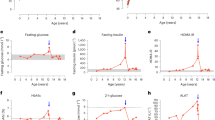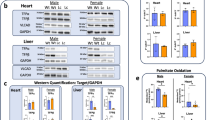Abstract
A MUTATION in the tub gene causes maturity-onset obesity, insulin resistance1, and sensory deficits2,3. In contrast to the rapid juvenile-onset weight gain seen in diabetes (db) and obese (ob) mice, obesity in tubby mice develops gradually, and strongly resembles the late-onset obesity seen in the human population. Excessive deposition of adipose tissue eventually leads to a twofold increase of body weight. Tubby mice also suffer retinal degeneration and neurosensory hearing loss2,3. The tripartite character of the tubby phenotype shows striking similarity to human obesity syndromes, such as Alström4 and Bardet-Biedl5. Here we report the identification of a G -→ T transversion in a candidate gene that abolishes a donor splice site in the 3′ coding region and results in a larger transcript containing the unspliced intron. This alteration is predicted to replace the 44-carboxy-terminal amino acids with a 20-amino-acid sequence not found in the wild-type protein. Additionally, a second, prematurely truncated transcript with the unspliced intron is observed in testis messenger RNA and a 2–3-fold increase in brain mRNA is observed in tubby mice compared to B6. The phenotypic features of tubby mice may be the result of cellular apoptosis triggered by expression of the mutated tub gene.
This is a preview of subscription content, access via your institution
Access options
Subscribe to this journal
Receive 51 print issues and online access
$199.00 per year
only $3.90 per issue
Buy this article
- Purchase on Springer Link
- Instant access to full article PDF
Prices may be subject to local taxes which are calculated during checkout
Similar content being viewed by others
References
Coleman, D. L. & Eicher, E. M. J. Heredity 81, 424–427 (1990).
Heckenlively, J. R. et al. Proc. natn. Acad. Sci. U.S.A. 92, 11100–11104 (1995).
Ohlemiller, K. K. et al. NeuroReport 6, 845–849 (1995).
Alström, C. H., Hallgren, B., Nilsson, L. B., & Asander, H. Acta psychiat. neurol. scand. 129, 1–35 (1959).
Bray, G. A. Obesity Res. 3, 383–403 (1995).
Jones, J. M., Meisler, M. H., Seldin, M. F., Lee, B. K. & Eicher, E. M. Genomics 14, 197–199 (1992).
North, M. et al. Mamm. Gen. 4, 466–474 (1993).
Lovett, M. Current Protocols in Human Genetics (eds Dracopoli, N. C. et al.) 6.3.1–13 (Current Protocols, New York, 1994).
Segre, J. A., Nemhauser, J. L., Taylor, B. A., Nadeau, J. H. & Lander, E. S. Genomics 28, 549–559 (1995).
Altschul, S. F., Gish, W., Miller, W., Myers, E. W. & Lipman, D. J. J. molec. Biol. 215, 403–410 (1990).
Vambutas, V. & Wolgemuth, D. J. Biochim. biophys. Acta 1217, 203–206 (1994).
Wilson, R. et al. Nature 368, 32–38 (1994).
Beavo, J. A. Physiol. Rev. 75, 725–748 (1995).
Lacombe, M.-L., Podgorski, G. J., Franke, J. & Kessin, R. H. J. biol. Chem. 261, 16811–16817 (1986).
Bowes, C. et al. Nature 347, 677–680 (1990).
Farber, D. B., Flannery, J. G. & Bowes-Rickman, C. Prog. Ret. Eye Res. 13, 31–64 (1994).
Wong, P. Biochem. Cell Biol. 72, 489–498 (1994).
Dietrich, W. F. et al. Nature Genet. 7, 220–245 (1994).
Naggert, J. K. et al. Nature Genet. 10, 135–141 (1995).
Schuler, G. D., Aitschul, S. F. & Lipman, D. J. Proteins Struct. Funct. Genet. 9, 180–190 (1991).
Author information
Authors and Affiliations
Rights and permissions
About this article
Cite this article
Noben-Trauth, K., Naggert, J., North, M. et al. A candidate gene for the mouse mutation tubby. Nature 380, 534–538 (1996). https://doi.org/10.1038/380534a0
Received:
Accepted:
Issue Date:
DOI: https://doi.org/10.1038/380534a0
This article is cited by
-
A novel homozygous TUB mutation associated with autosomal recessive retinitis pigmentosa in a consanguineous Chinese family
BMC Medical Genomics (2023)
-
Microtubule-associated protein 1 A and tubby act independently in regulating the localization of stereocilin to the tips of inner ear hair cell stereocilia
Molecular Brain (2022)
-
Tubby-like proteins (TLPs) transcription factor in different regulatory mechanism in plants: a review
Plant Molecular Biology (2022)
-
A tubby-like protein CsTLP8 acts in the ABA signaling pathway and negatively regulates osmotic stresses tolerance during seed germination
BMC Plant Biology (2021)
-
A combined genome-wide association and molecular study of age-related hearing loss in H. sapiens
BMC Medicine (2021)
Comments
By submitting a comment you agree to abide by our Terms and Community Guidelines. If you find something abusive or that does not comply with our terms or guidelines please flag it as inappropriate.



